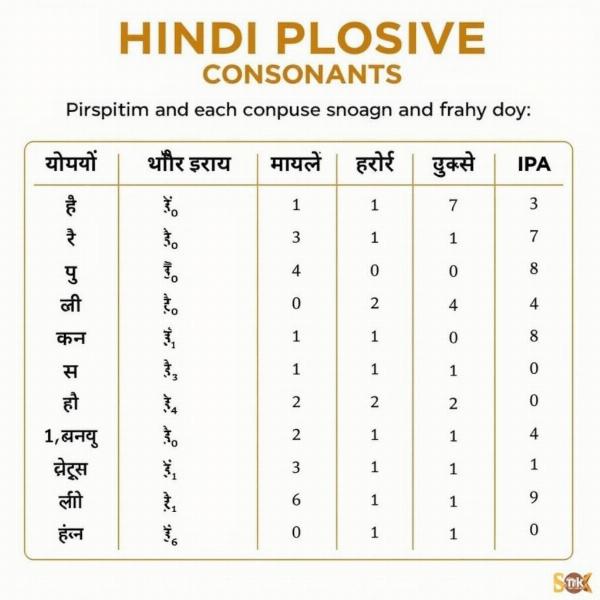Understanding plosives, also known as stop consonants, is crucial for anyone learning or teaching Hindi. These sounds, formed by completely blocking airflow in the vocal tract and then releasing it, play a significant role in the pronunciation and clarity of spoken Hindi. This guide will delve into the meaning, pronunciation, and significance of plosives in Hindi, offering valuable insights for language enthusiasts.
What are Plosives in Hindi? (स्पर्श व्यंजन – Sparsh Vyanjan)
Plosives in Hindi are categorized as स्पर्श व्यंजन (Sparsh Vyanjan), literally meaning “touch consonants.” This name aptly describes the manner of their articulation, where the tongue or lips momentarily touch a specific point in the mouth, creating a complete closure before the sound is released. These sounds are fundamental to the Hindi phonetic system. Mastering them is essential for accurate pronunciation and comprehension. They contribute significantly to the rhythmic and melodic nature of the language. Knowing how these sounds function helps distinguish between similar-sounding words and improves overall fluency.
 Hindi Plosive Consonants Chart
Hindi Plosive Consonants Chart
Categories of Plosives in Hindi
Hindi plosives are classified based on where the airflow is blocked:
- Velar (क वर्ग – Ka Varga): These sounds are produced at the back of the mouth where the tongue touches the velum (soft palate). Examples include क (ka), ख (kha), ग (ga), घ (gha), and ङ (nga).
- Palatal (च वर्ग – Cha Varga): Formed by the tongue touching the hard palate, examples of palatal plosives include च (cha), छ (chha), ज (ja), झ (jha), and ञ (nya).
- Retroflex (ट वर्ग – Ta Varga): These unique sounds are produced by curling the tongue back and touching the roof of the mouth. Examples include ट (ta), ठ (tha), ड (da), ढ (dha), and ण (na).
- Dental (त वर्ग – Ta Varga): These plosives involve the tongue touching the back of the teeth. Examples are त (ta), थ (tha), द (da), ध (dha), and न (na).
- Bilabial (प वर्ग – Pa Varga): Produced by bringing the lips together, bilabial plosives include प (pa), फ (pha), ब (ba), भ (bha), and म (ma).
Importance of Plosives in Hindi Pronunciation
Accurate pronunciation of plosives is crucial for clear communication in Hindi. Mispronouncing these sounds can lead to misunderstandings and confusion. For instance, the difference between “kal” (tomorrow) and “gal” (cheek) lies in the initial plosive. Therefore, mastering these sounds is essential for effective communication. They form the backbone of many Hindi words, impacting both meaning and rhythm.
How Does Aspiration Affect Plosives?
Many Hindi plosives have aspirated and unaspirated forms. Aspiration refers to a puff of air released with the sound. The aspirated forms are denoted with an ‘h’ following the consonant in Roman transliteration (e.g., kha, tha, pha). Distinguishing between aspirated and unaspirated plosives is essential for correct pronunciation and understanding.
Plosives in Hindi Grammar
Plosives also play a significant role in Hindi grammar. They are crucial for forming verb conjugations and noun declensions. Understanding their function within grammatical structures enhances your overall grasp of the language.
Plosive Examples in Hindi Words
Here are some examples of Hindi words showcasing the use of plosives:
- कान (kaan) – Ear: Utilizes the velar plosive ‘ka’.
- छाता (chhata) – Umbrella: Features the palatal plosive ‘chha’.
- डाक (daak) – Post/Mail: Demonstrates the retroflex plosive ‘da’.
- दिन (din) – Day: Employs the dental plosive ‘da’.
- बाल (baal) – Hair: Uses the bilabial plosive ‘ba’.
Conclusion
Plosives, or Sparsh Vyanjan, are fundamental components of the Hindi language. Understanding their articulation, categories, and influence on pronunciation and grammar is essential for anyone learning or teaching Hindi. By mastering these sounds, you will significantly improve your communication skills and deepen your appreciation for the intricacies of this rich language.
FAQ
- What is the difference between aspirated and unaspirated plosives? Aspiration involves a puff of air released with the plosive sound, while unaspirated plosives are produced without this extra air.
- Why are plosives called Sparsh Vyanjan in Hindi? “Sparsh” means touch, reflecting how these consonants are formed by a momentary closure in the vocal tract.
- How many categories of plosives are there in Hindi? Five: velar, palatal, retroflex, dental, and bilabial.
- Are plosives important for Hindi grammar? Yes, they are crucial for verb conjugations and noun declensions.
- How can I improve my pronunciation of Hindi plosives? Practice and listening to native speakers are key to mastering these sounds.
plosive meaning in hindi
what is the meaning of mine in hindi
hindi meaning of mine
sapper meaning in hindi
Meaning-Hindi.in is your premier destination for professional Hindi translation services, specializing in various domains, from business and legal documents to technical manuals, website localization, educational materials, and more. We offer fast, accurate, and culturally sensitive translations to bridge the language gap and facilitate effective communication. Contact us today for all your Hindi translation needs at [email protected] or call us at +91 11-4502-7584. Meaning-Hindi.in is committed to delivering high-quality translations that meet your specific requirements.